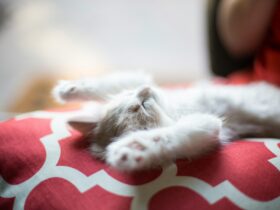Blog: How to Reduce Cat Dander & Allergies | Choosing the Best Food and Treats for Your Senior Cat
Introduction
As our feline companions age, their needs change, and it’s essential to adapt their care accordingly. One of the most common concerns for cat owners is managing cat dander and allergies. At the same time, selecting the right food and treats for your senior cat is crucial to ensure they remain healthy and happy in their golden years. This comprehensive guide will cover effective ways to reduce cat dander and manage allergies while also providing detailed advice on choosing the best food and treats for your senior cat.
How to Reduce Cat Dander & Allergies
1. Understanding Cat Dander and Allergies
What is Cat Dander? Cat dander is composed of tiny skin flakes that cats shed. These flakes often contain Fel d 1, a protein found in cat saliva and skin oils, which is a common allergen.
Symptoms of Cat Allergies
- Respiratory Issues: Sneezing, coughing, wheezing, and shortness of breath.
- Eye Irritation: Red, itchy, or watery eyes.
- Skin Reactions: Rashes, hives, or itching.
- Nasal Symptoms: Runny or stuffy nose.
2. Effective Strategies to Reduce Cat Dander
a. Regular Grooming Brushing your cat daily helps remove loose fur and dander, reducing the amount of allergens in your home. Opt for a dander-reducing brush, which can be particularly effective in minimizing dander spread.
b. Bathing Your Cat Bathing your cat with a hypoallergenic shampoo can significantly reduce dander. While cats generally don’t need frequent baths, once a month can help manage dander levels effectively.
c. Diet and Supplements Feeding your cat a diet rich in omega-3 and omega-6 fatty acids can improve skin health, leading to less dander production. Fish oil supplements or cat food with added fatty acids can be beneficial.
d. Improve Air Quality Invest in a HEPA air purifier to capture airborne dander particles. Place it in rooms where your cat spends the most time. Additionally, regularly change air filters in your home to reduce the presence of dander.
e. Cleaning Routine Vacuum your home frequently using a vacuum cleaner with a HEPA filter to trap dander. Wash your cat’s bedding, your linens, and any fabric surfaces where your cat frequently rests.
f. Allergy Medication If you or a family member suffers from cat allergies, consider taking antihistamines, decongestants, or nasal sprays to manage symptoms. Consult with a healthcare provider for the best options.
g. Designate Cat-Free Zones Create cat-free areas in your home, especially your bedroom. This will provide you with a dander-free space where you can relax and sleep without triggering allergy symptoms.
3. Long-Term Solutions for Managing Cat Allergies
a. Hypoallergenic Cat Breeds Some cat breeds, like the Siberian or Balinese, are known to produce less dander. If you’re considering adding a new cat to your family, choosing a hypoallergenic breed might be beneficial.
b. Allergy Immunotherapy Allergy shots, or immunotherapy, can help reduce your sensitivity to cat dander over time. This treatment requires a commitment to regular injections but can significantly improve symptoms in the long run.
Choosing the Best Food and Treats for Your Senior Cat
1. Understanding the Nutritional Needs of Senior Cats
Aging and Dietary Changes As cats age, their metabolism slows down, and their dietary needs change. Senior cats often require fewer calories but more nutrients that support joint health, digestion, and overall well-being.
Common Health Issues in Senior Cats
- Joint Problems: Arthritis and joint stiffness are common in older cats, requiring foods rich in glucosamine and chondroitin.
- Digestive Issues: Senior cats may experience reduced digestive efficiency, necessitating easily digestible foods.
- Kidney Health: Older cats are prone to kidney disease, making low-phosphorus diets important.
- Weight Management: Obesity can be a concern, so portion control and low-calorie foods may be necessary.
2. Choosing the Best Food for Your Senior Cat
a. High-Quality Protein Senior cats still need adequate protein to maintain muscle mass. Look for cat food with high-quality animal protein sources like chicken, turkey, or fish as the primary ingredient.
b. Joint Support Foods formulated for senior cats often contain joint-supporting nutrients like glucosamine and chondroitin. These can help alleviate arthritis symptoms and improve mobility.
c. Digestibility Choose food that is easy to digest, with ingredients like prebiotics, probiotics, and fiber to support a healthy digestive system. Wet food can be particularly beneficial as it is easier on their stomachs and provides additional moisture.
d. Kidney Health If your senior cat has kidney issues, opt for a diet that is low in phosphorus and protein. Prescription diets designed for kidney health can help manage the condition and reduce the strain on their kidneys.
e. Weight Management For overweight senior cats, select a low-calorie, high-fiber diet that helps them feel full without overeating. Controlled portions and feeding schedules are essential to prevent further weight gain.
f. Hydration Senior cats can be prone to dehydration, especially if they have kidney problems. Wet food is an excellent way to increase water intake. You can also add water to dry kibble to enhance hydration.
3. Best Treats for Senior Cats
a. Low-Calorie Treats Since senior cats are less active, opt for low-calorie treats that won’t contribute to weight gain. Look for treats that offer added health benefits, such as joint support or digestive aids.
b. Soft Treats Senior cats may have dental issues that make chewing hard treats difficult. Soft, chewy treats are easier for them to enjoy and are gentler on their teeth.
c. Functional Treats Treats that contain ingredients beneficial for senior cats, such as omega-3 fatty acids, glucosamine, or probiotics, can provide health benefits while also being a tasty reward.
d. Limited Ingredients If your senior cat has food sensitivities or allergies, choose treats with limited ingredients to avoid potential allergens. Look for single-protein treats or those made with simple, natural ingredients.
e. Hydrating Treats Some treats come in the form of broths or moisture-rich snacks, which can help with hydration. These can be particularly beneficial for cats with kidney issues or those who don’t drink enough water.
4. Tips for Transitioning Your Senior Cat to New Food
a. Gradual Introduction When introducing a new food, do so gradually over a week. Start by mixing a small amount of the new food with the old, gradually increasing the proportion of new food.
b. Monitor Health and Behavior Keep an eye on your cat’s health and behavior during the transition. Watch for any signs of digestive upset or changes in appetite. If any issues arise, consult your veterinarian.
c. Regular Veterinary Check-Ups Senior cats should have regular veterinary check-ups to monitor their health and ensure their diet meets their changing needs. Your vet can provide recommendations for the best food and treats based on your cat’s specific health conditions.
Conclusion
Managing cat dander and allergies while ensuring your senior cat receives the proper nutrition and treats requires thoughtful planning and care. By implementing the strategies to reduce dander and choosing the right food and treats tailored to your senior cat’s needs, you can enhance your feline companion’s quality of life. Whether your goal is to keep allergies at bay or to provide the best possible care for your aging cat, the tips and recommendations in this guide will help you achieve a healthier and happier home for both you and your cat.











Leave a Reply